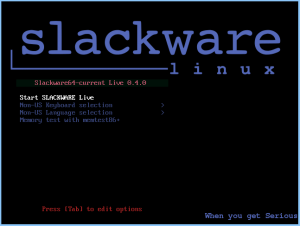 I have uploaded a new ‘ktown’ package set. KDE 5_16.02 contains the latest KDE releases: Frameworks 5.19.0, Plasma 5.5.4 and Applications 15.12.2. I had been sitting on this for a few days, and was waiting for Pat to release his own new batch of updates for slackware-current. With a fresh kernel and glibc in -current and new Plasma5 packages, it is almost time to create new ISO images for the Slackware Live Edition. More about liveslak in the next post.
I have uploaded a new ‘ktown’ package set. KDE 5_16.02 contains the latest KDE releases: Frameworks 5.19.0, Plasma 5.5.4 and Applications 15.12.2. I had been sitting on this for a few days, and was waiting for Pat to release his own new batch of updates for slackware-current. With a fresh kernel and glibc in -current and new Plasma5 packages, it is almost time to create new ISO images for the Slackware Live Edition. More about liveslak in the next post.
What’s new in KDE 5_16.02?
- Frameworks 5.19.0 is an enhancement release. See https://www.kde.org/announcements/kde-frameworks-5.19.0.php .
- Plasma 5.5.4 is an incremental bug & stability update for the 5.5 series. See https://www.kde.org/announcements/plasma-5.5.4.php .
- Note that these Plasma 5.5.4 packages were already released in ‘ktown‘ on February 4th as an incremental update.
- The Applications 15.12.2 is a bugfix release. For a full list of changes to applications, read this page.
- The ‘kjots’ package was added. This used to be part of KDEPIM and has now been released as a separate tarball.
- KDE Telepathy is still missing the graphical voice&video chat application ‘ktp-call-ui’. At least, it is missing a stable release. I used a git snapshot to compile a package now that it finally has a new maintainer who finished the port to KF5 (KDE Frameworks 5). Inclusion of a stable release of ‘ktp-call-ui’ is expected in Applications 16.04.
I am preparing ISO images for the new 0.6.0 (Beta6) release of my Slackware Live Edition. These ISOs are based on the latest Slackware64-current. The PLASMA5 variant contains my KDE-5_16.02 packages. You can play-test the new desktop in a Live OS without the hassle of installing it to your hard drive (although that will be possible).
Installing or upgrading Frameworks 5, Plasma 5 and Applications
You can skip the remainder of the article if you already have my Plasma 5 installed and are familiar with the upgrade process. Otherwise, stay with me and read the rest.
As always, the accompanying README file contains full installation & upgrade instructions. Note that the packages are available in several subdirectories below “kde”, instead of directly in “kde”. This makes it easier for me to do partial updates of packages. The subdirectories are “kde4”, “kde4-extragear”, “frameworks”, “kdepim”, “plasma”, “plasma-extra”, “applications”, “applications-extra” and “telepathy”.
Upgrading to this KDE 5 is not difficult, especially if you already are running KDE 5_16.01. You will have to remove old KDE 4 packages manually. If you do not have KDE 4 installed at all, you will have to install some of Slackware’s own KDE 4 packages manually.
Note:
If you are using slackpkg+, have already moved to KDE 5_16.01 and are adventurous, you can try upgrading using the following set of commands. This should “mostly” work but you still need to check the package lists displayed by slackpkg to verify that you are upgrading all the right packages. Feel free to send me improved instructions if needed. In below example I am assuming that you tagged my KDE 5 repository with the name “ktown_testing” in the configuration file “/etc/slackpkg/slackpkgplus.conf“):
# slackpkg update
# slackpkg install ktown_testing (to get the newly added packages from my repo)
# slackpkg install-new (to get the new official Slackware packages that were part of my deps previously)
# slackpkg upgrade ktown_testing (upgrade all existing packages to their latest versions)
# removepkg xembed-sni-proxy ktux amor kde-base-artwork kde-wallpapers kdeartwork (they don’t exist in the repo anymore)
# slackpkg upgrade-all (upgrade the remaining dependencies that were part of my repo previously)
And doublecheck that you have not inadvertently blacklisted my packages in “/etc/slackpkg/blacklist“! Check for the existence of a line in that blacklist file that looks like “[0-9]+alien” and remove it if you find it!
Recommended reading material
There have been several posts now about KDE 5 for Slackware-current. All of them contain useful information, tips and gotchas that I do not want to repeat here, but if you want to read them, here they are: http://alien.slackbook.org/blog/tag/kde5/
A note on Frameworks
The KDE Frameworks are extensions on top of Qt 5.x and their usability is not limited to the KDE Software Collection. There are other projects such as LXQT which rely (in part) on the KDE Frameworks, and if you are looking for a proper Frameworks repository which is compatible with Slackware package managers such as slackpkg+, then you can use these URL’s to assure yourself of the latest Frameworks packages for Slackware-current (indeed, this is a sub-tree of my KDE 5 “testing” repository):
Where to get the new packages for Plasma 5
Download locations are listed below (you will find the sources in ./source/5/ and packages in /current/5/ subdirectories). If you are interested in the development of KDE 5 for Slackware, you can peek at my git repository too.
Using a mirror is preferred because you get more bandwidth from a mirror and it’s friendlier to the owners of the master server!
Have fun! Eric
 BrewDog, a UK brewery which soon celebrates its tenth anniversary, has decided to “open source” all of their 215 beer recipes. From their original and still extremely popular (and tasty) beer “PUNK IPA“, moving on to “Hops Kill Nazis“, “Doodlebug” and finally arriving at their latest “Jet Black Heart” which was first brewed last month (!)
BrewDog, a UK brewery which soon celebrates its tenth anniversary, has decided to “open source” all of their 215 beer recipes. From their original and still extremely popular (and tasty) beer “PUNK IPA“, moving on to “Hops Kill Nazis“, “Doodlebug” and finally arriving at their latest “Jet Black Heart” which was first brewed last month (!)


Recent comments